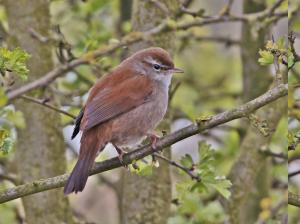


The Cetti's Warbler is becoming fairly common in scrubby reedbeds in Nottinghamshire. Easily noticed by its explosive song, but not so easily seen.
Cetti's Warbler was unknown to Sterland and his Victorian compatriots. In the 1920s it started to spread northwards from its Mediterranean base and was first recorded in Britain in 1961, with breeding first noticed in 1973. It first bred in Nottinghamshire in 2007 at Attenborough. Now there are at least seven singing males and it has spread to several other sites in the Trent Valley. The recent cold winters have done nothing to reduce its rapid spread to occupy every square metre of its habitat (reedbeds with scrub).
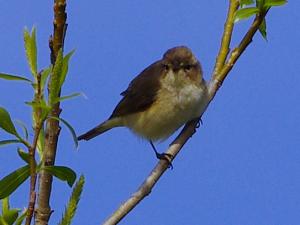
Chiffchaffs have a simple breeding requirement of trees as songposts and undergrowth for the nests and is classed a a common summer visitor to Nottinghamshire. The Chiffchaff population has increased its numbers by 83% in the last 12 years (BBS index for the East Midlands).
A few winter, or move in from the continent, often in Sewage works. For instance the one at Toton (near Attenborough NR) can have four or so birds, even the less welcoming one (with less hedges) at Beeston Rylands, can hold two.
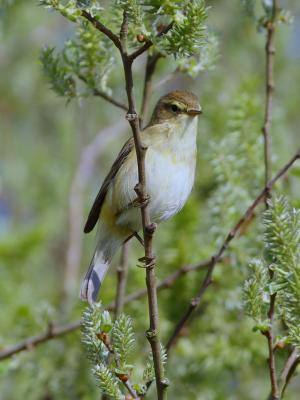
The Willow Warbler prefers open woodland, scrub and bushy areas, it is considered a common summer visitor, but in recent years there have been lower numbers in the south of Nottinghamshire, although the north of the county the population still remains strong. From the BBS index for the East Midlands Willow Warbler numbers have declined by 47% in the last 13 years. In Sterland's time in the second half of the nineteenth century it was an abundant summer visitor. An old name for the Willow Warbler was Willow Wren.
Its cascading rippling song is one of the iconic sounds of a British spring.
It will breed anywhere where there is some thick vegetation and low trees or shrubs, this includes heathland with birch, glades and rides in woods, tall and untidy hedgerows and mature gravel pit banks. It occurs all over Nottinghamshire apart from heavily built-up areas and prairie type farmland.
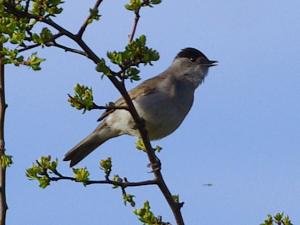
The Blackcap is frequently found in woodland with a good shrub layer, overgrown hedgerows and even garden shrubbery, so it is common summer visitor to Nottinghamshire, and according to the BBS index for the East Midlands the population of Blackcaps has increased by around 36% in the last 13 years.
Its song, mainly given in April, May and June is loud and rich and is a rival to the Blackbird and Nightingale as Nottinghamshire's best songster.
It is also a commonly seen hedgerow migrant in August and early September. A few Blackcaps spend the winter in Nottinghamshire.
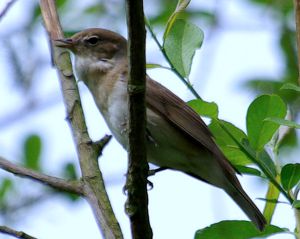
The Garden Warbler is closely related to the Blackcap and shares much the same habitats in Nottinghamshire, but is not as common in woodland, although it will occupy woodland rides and open woodland with a scrubby underlayer. Usually keeps more in cover than the Blackcap. The song is also similar but deeper, more warbling, lacking the Blackcap's flute type finish. The male birds arrive in late April or early May and take up territories straight away. The females arrive a week or so later. When the birds are paired the males sing much less.
The Garden Warbler is a fairly common summer visitor to Nottinghamshire. It is not often seen after the end of July, unlike its cousin the Blackcap, which remains fairly common until mid-September.
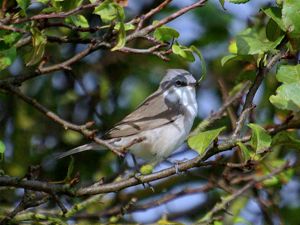
The Lesser Whitethroat is the only Nottinghamshire migrant which arrives via the Middle East, from its wintering areas in East Africa. Almost all of Nottinghamshire's other migrants follow a north/south path.
In Nottinghamshire it is a fairly common summer visitor in its habitat of thick, overgrown hedges, but is local. Sterland (List of the Birds of Nottinghamshire{1879}) considered the Lesser Whitethroat was almost as common as the Common Whitethroat, a situation somewhat different than 2009.
Hard to see when it arrrives in late April and early May, as it skulks in thick cover and is normally only identified by its rattling song. Later in the summer (August, early September) it becomes a common hedgerow migrant and is a lot easier to see as family parties rove around before migrating.
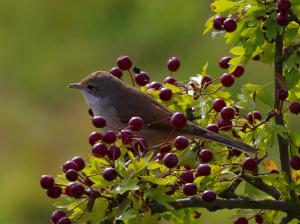
The Common Whitethroat is a scrub-loving bird and lives in habitats such as uncultivated ground, untidy hedges, gravel pit margins, canalsides, young forestry plantations and woodland edges. Obviously it has a wide distribution in Nottinghamshire and its status is classed as a common summer visitor.
In 1969 there was a collapse in the numbers of Common Whitethroats arriving in western Europe, because of droughts in its wintering areas of the Sahel. The numbers fell to around 20% by the early 1970s as compared with its numbers in the years just prior to 1969. It took many years — into the nineties, before the populations were restored to their previous level. Its scratchy song is once again a typical sound of summer. Sterland in A Descriptive List of Nottinghamshire Birds {1879} says the Common Whitethroat was a common species and widely spread.
It is commonly seen in the late summer as it is a classic 'hedgerow migrant', moving along shrubs and hedges in loose parties, feeding as they move along.
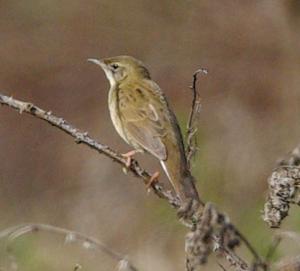
The Grasshopper Warbler is an uncommon summer visitor to Nottinghamshire, but is widely distributed. Its habitat is thick, tangled, low vegetation with some higher points such as brambles or hawthorn scrub to provide a song post. In fact it's a good thing that it does sing (or rather reel) otherwise with its secretive nature it would be hard to find.
In Nottinghamshire it is found at Attenborough, Netherfield and some of the less developed old pit-tops. Sterland in his (List of the Birds of Nottinghamshire{1879}) believed that the Grasshopper Warbler was more plentiful than it appeared to be and could be found easily enough in in suitable habitats.
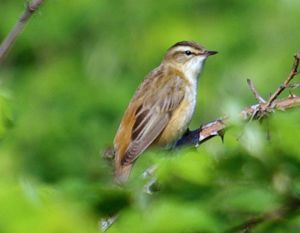
The Sedge Warbler likes the rich and luxuriant vegetation at the margins of rivers and gravel pits. It also likes ditches, in fact anywhere damp with rich vegetation and a few shrubs or small trees for a songpost, from which it sometimes bursts out in an energetic and noisy song flight. In the south of the county it sometimes breeds in oilseed rape fields.
Its status in Nottinghamshire is classed as common, but local. The main centres of population are at Netherfield, Attenborough, Lound and Langford Lowfields.
Sterland {1879} considered the Sedge Warbler as "very common everywhere, and it takes good care to make its presence known", a reference to its exuberant and loud song.
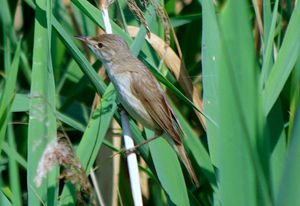
The name Reed Warbler gives a very good idea where this bird breeds, despite this association, it does sometimes breed in shrubs such as hawthorn close to the reedbeds.
The main nesting sites in Nottinghamshire are, of course, where the reedbeds are Attenborough, Netherfield, Langford Lowfields and Lound. In these places it is common and easily found, or heard at least. It can breed in small reedbeds, such as along the Beeston Canal, or the one on Wollaton Park lake.
Sterland (List of the Birds of Nottinghamshire{1879}) considered the Reed Warbler as common where reedbeds were present, most of which, in the mid-nineteenth century would have been along the river Trent.
Any criticisms, corrections or comments to the author Derek Huskisson

This work is licensed under a Creative Commons Attribution-Noncommercial-Share Alike 2.0 UK: England & Wales License.